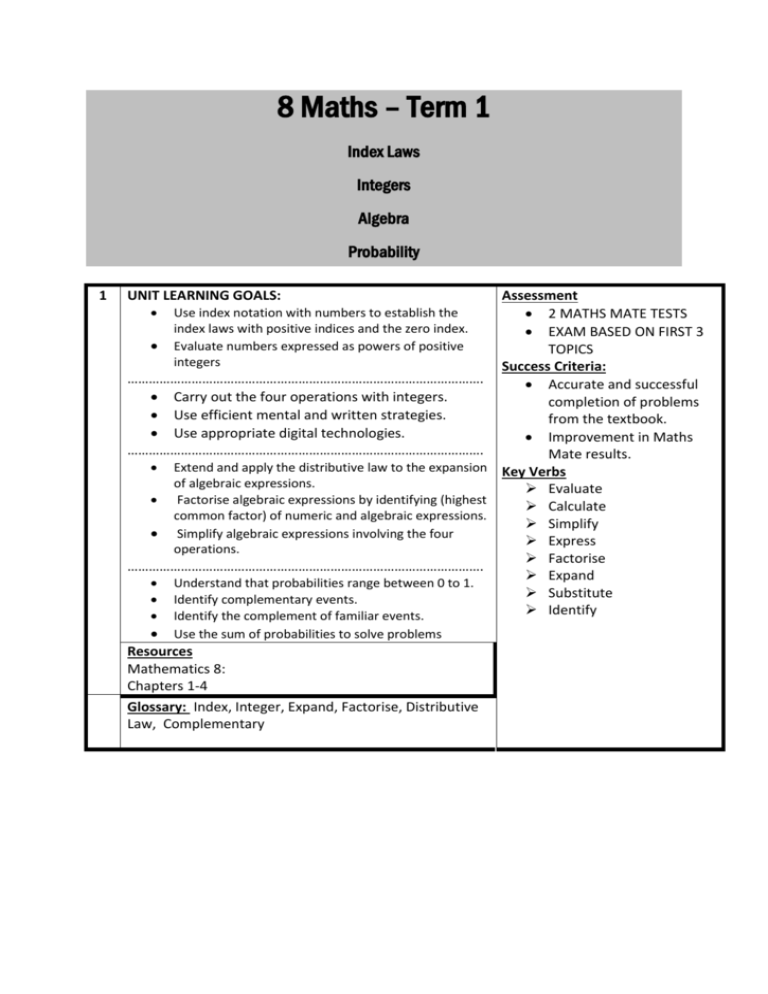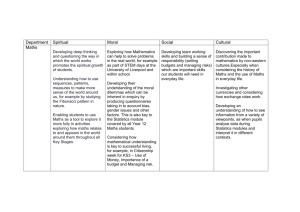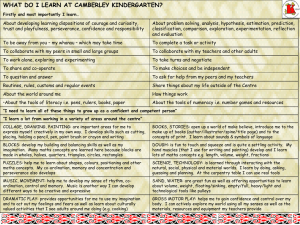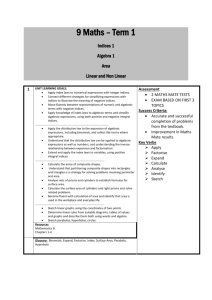Year 8 Unit Plan
advertisement

8 Maths – Term 1 Index Laws Integers Algebra Probability 1 UNIT LEARNING GOALS: Assessment Use index notation with numbers to establish the 2 MATHS MATE TESTS index laws with positive indices and the zero index. EXAM BASED ON FIRST 3 Evaluate numbers expressed as powers of positive TOPICS integers Success Criteria: ………………………………………………………………………………………. Accurate and successful Carry out the four operations with integers. completion of problems Use efficient mental and written strategies. from the textbook. Use appropriate digital technologies. Improvement in Maths ………………………………………………………………………………………. Mate results. Extend and apply the distributive law to the expansion Key Verbs of algebraic expressions. Evaluate Factorise algebraic expressions by identifying (highest Calculate common factor) of numeric and algebraic expressions. Simplify Simplify algebraic expressions involving the four Express operations. Factorise ………………………………………………………………………………………. Expand Understand that probabilities range between 0 to 1. Substitute Identify complementary events. Identify Identify the complement of familiar events. Use the sum of probabilities to solve problems Resources Mathematics 8: Chapters 1-4 Glossary: Index, Integer, Expand, Factorise, Distributive Law, Complementary 8 Maths – Term 2 Real Numbers Data Circles Congruence 1 UNIT LEARNING GOALS: Recognise terminating, recurring and non-terminating decimals and choose their appropriate representations. Investigate the concept of irrational numbers, including π. Understand that the real number system includes irrational numbers and that certain subsets of the real number system have particular properties …………………………………………………………………………………………………………………………… Use sample properties to predict characteristics of the population. Use displays of data to explore and investigate effects. Explore the practicalities and implications of obtaining representative data. Understand that making decisions and drawing conclusions based on data may differ from those based on preferences and beliefs. Investigate the effect of individual data values, including outliers, on the mean and median. …………………………………………………………………………………………………………………………… Investigate the relationship between features of circles such as circumference, area, radius and diameter. Use formulas to solve problems involving circumference and area. Investigate the circumference and area of circles with materials or by measuring, to establish an understanding of formulas. Investigate the area of circles using a square grid or by rearranging a circle divided into sectors. ………………………………………………………………………………………………………………………. Two figures are congruent if one shape lies exactly on top of the other after one or more transformations (translation, reflection, rotation). Solve problems using properties of congruent figures, justifying reasoning and making generalisations. The minimal conditions for congruence (SSS, SAS, ASA and RHS) and the conditions that do not prescribe congruence (ASS, AAA). Plot the vertices of two-dimensional shapes on the Cartesian plane, translating, rotating or reflecting the shape and using coordinates to describe the transformation Resources Mathematics 8: Chapters 6-9 Glossary: Rational, Irrational, Recurring, Terminating, Congruence, Transformation, Population, Census, Mean, Median, Mode circumference Assessment 2 MATHS MATE TESTS EXAM BASED ON FIRST 3 TOPICS Success Criteria: Accurate and successful completion of problems from the textbook. Improvement in Maths Mate results. Key Verbs Investigate Solve Explore Calculate 8 Maths – Term 3 Rate and Ratio Linear Equations Time Data 1 UNIT LEARNING GOALS: Use percentages to solve problems, including those involving mark-ups, discounts, profit and loss and GST. Express profit and loss as a percentage of cost or selling price, compare the difference. Investigate the methods used in retail stores to express discounts. Solve a range of problems involving rates and ratios, with and without digital technologies Understand that rate and ratio problems can be solved using fractions or percentages and choosing the most efficient form to solve a particular problem. Calculate population rates in Australia and Asia and explain their difference. ……………………………………………………………………………………………………………………………. Solve linear equations using algebraic and graphical techniques. Use variables to symbolise simple linear equations and use a variety of strategies to solve them. Solve equations using concrete materials, such as the balance model, and explain the need to do the same thing to each side of the equation. ………………………………………………………………………………………………………………………… Solve problems involving duration, including using 12-hour and 24-hour time within a single time zone. Calculate travel times given the start and finish time in 12-hour and 24hour time including where the start and end time are in different time zones. Identify regions in Australia and countries in Asia that are in the same time zone. ………………………………………………………………………………………………………………………….. Explore the practicalities and implications of obtaining representative data. Understand that making decisions and drawing conclusions based on data may differ from those based on preferences and beliefs. Explore the variation of means and proportions in representative data. Investigate an international issue where media reporting and the use of data reflect different cultural or social emphases. Use sample properties to predict characteristics of the population. Resources Mathematics 8: Chapters 11-14 Glossary: Profit, Loss, GST, Discount, Time Zone, Sample, Bias Assessment 2 MATHS MATE TESTS EXAM BASED ON FIRST 3 TOPICS Success Criteria: Accurate and successful completion of problems from the textbook. Improvement in Maths Mate results. Key Verbs Calculate Solve Investigate 8 Maths – Term 4 Linear Relationships Measurement Probability Congruence 1 UNIT LEARNING GOALS: Plot linear relationships on the Cartesian plane. Plot points for tables of values from non-rule-based data. Solve linear equations using algebraic and graphical techniques. Use variables to symbolise simple linear equations. ……………………………………………………………………………………………………………………… Find perimeters and areas of parallelograms, rhombuses and kites. Explore the use of parallelograms, rhombuses and kites in art and architecture. Develop the formulas for volumes of rectangular and triangular prisms and prisms in general. Use formulas to solve problems involving volume. Investigate the relationship between volumes of rectangular and triangular prisms. ……………………………………………………………………………………………………………………… Understand that representing data in Venn diagrams or two-way tables facilitates the calculation of probabilities. Use Venn diagrams and two-way tables to calculate probabilities for events satisfying ‘and’, ‘or’, ‘given’ and ‘not’ conditions. Pose ‘and’, ‘or’, ‘not’ and ‘given’ probability questions about objects or people. Collect data to answer the questions using Venn diagrams or twoway tables ………………………………………………………………………………. Develop the conditions for congruence of triangles. Construct triangles using the conditions for congruence. Solve problems using the properties of congruent figures. Establish of the conditions for congruence (SSS, SAS, ASA and RHS) to solve problems. Establish the properties of squares, rectangles, parallelograms, rhombuses, trapeziums and kites. Resources Mathematics 8: Chapters 16-19 Glossary: Cartesian Plane, Linear, Parallelogram, Rhombus, Prism, Kite, Congruence Assessment 2 MATHS MATE TESTS EXAM BASED ON FIRST 3 TOPICS Success Criteria: Accurate and successful completion of problems from the textbook. Improvement in Maths Mate results. Key Verbs Plot Calculate Solve Investigate Pose Collect Explore Construct










